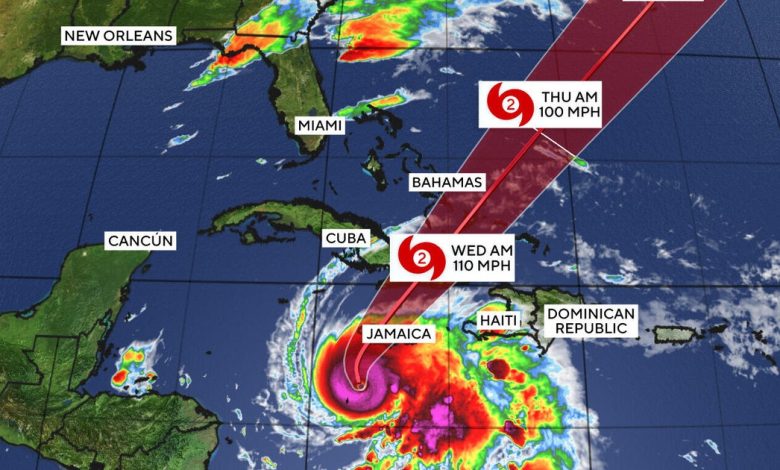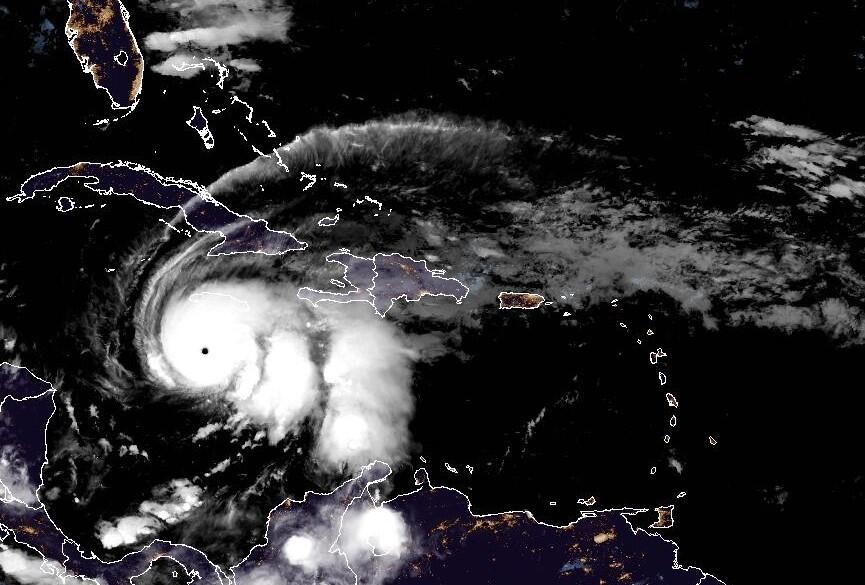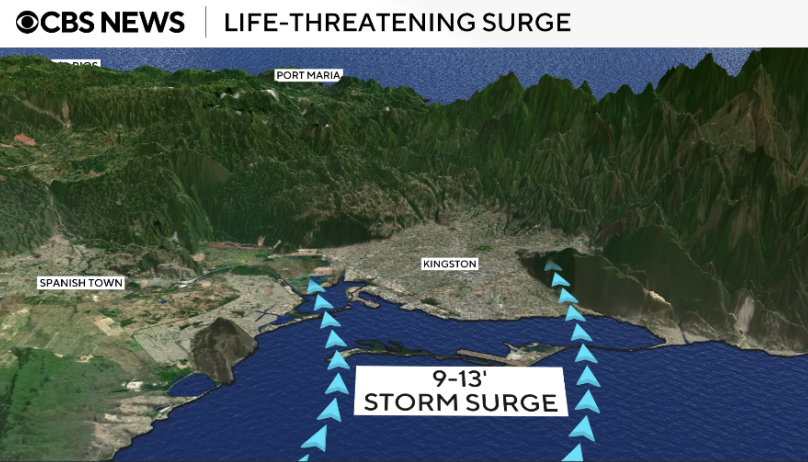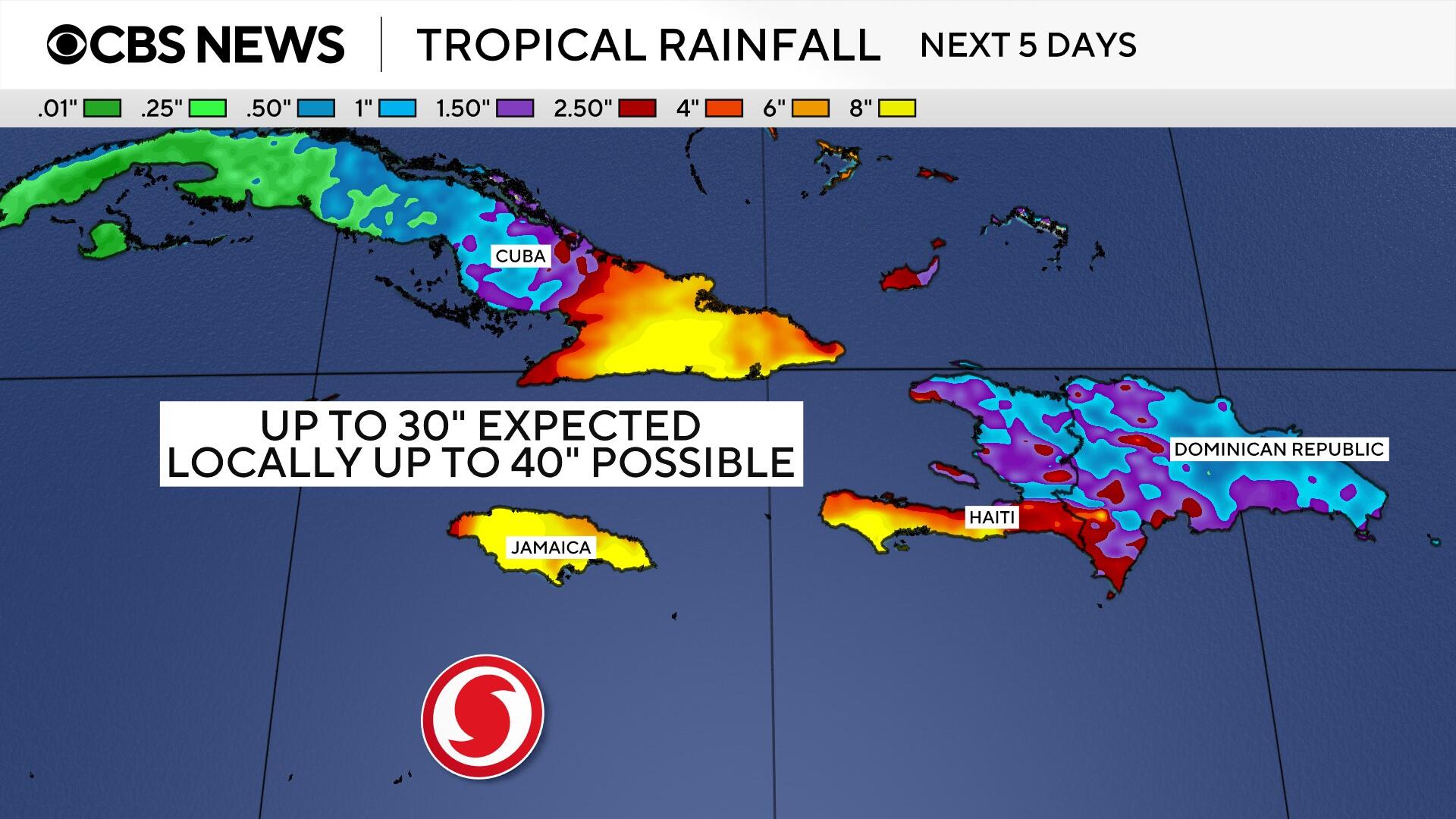Hurricane Melissa is a mighty Category 5 storm in the Caribbean. Maps show its forecast path.

Melissa strengthened into a Category 5 hurricane on Monday and was forecast to bring “life-threatening and potentially catastrophic” flash flooding and landslides to Jamaica, southern parts of Haiti and the Dominican Republic, and eastern Cuba over the next few days, the Miami-based National Hurricane Center warned.
Hurricane Melissa, the 13th named storm of the Atlantic season, isn’t expected to have major impacts on the mainland United States, but it’s turning into the strongest Atlantic system this season.
Melissa’s forecast and path
The storm had maximum sustained winds of 175 mph as of the NHC’s 5 p.m. ET update Monday. Hurricanes reach Category 5 — the top of the Saffir-Simpson Hurricane Wind Scale — when their winds hit 157 mph.
Melissa’s center was about 140 miles southwest of Kingston, Jamaica, and about 320 miles southwest of Guantanamo, Cuba, as of the latest hurricane center update. Hurricane-force winds extended some 30 miles from the storm’s center, and tropical storm-force winds extended 195 miles. The storm was crawling northwest at 3 mph.
CBS News
“The core of Melissa is expected to move over Jamaica tonight and Tuesday, across southeastern Cuba Tuesday night, and across the southeastern Bahamas on Wednesday,” the hurricane center said Monday.
Forecasters said the storm’s intensity would likely fluctuate ahead of its landfall. But, they added, “Melissa is expected to reach Jamaica and southeastern Cuba as an extremely powerful major hurricane, and will still be at hurricane strength when it moves across the southeastern Bahamas.”
When Melissa makes landfall, peak storm surge accompanied by destructive waves is forecast to reach 9 to 13 feet above ground level in Jamaica and 6 to 9 feet in Cuba.
The storm’s slow pace also raises the risk of destructive impacts, particularly in Jamaica.
“The devastation is going to be so profound because the storm is moving slowly,” CBS News Philadelphia meteorologist Grant Gilmore said Monday. “It’s going to remain at a very slow pace as it traverses the island. … All of the threats that a hurricane can unleash on an island, it’s all going to happen in Jamaica over the next 36 hours.”
Melissa could be the most powerful hurricane ever to hit Jamaica.
“The island’s terrain makes it even worse,” CBS News Philadelphia meteorologist Andrew Kozak explained. “Jamaica’s mountains force the air to rise, and that creates more rain.”
The strongest previous hurricane to pound Jamaica was Gilbert in 1988, Kozak said. It killed 45 people and caused more than $700 million in damage.
NOAA / National Hurricane Center
Hurricane advisories
A hurricane warning is in effect for Jamaica and the Cuban provinces of Granma, Santiago de Cuba, Guantanamo and Holguin.
A hurricane warning is in effect for the southeastern and central Bahamas, according to the Meteorological Service of the Bahamas. A tropical storm warning was issued for the Turks and Caicos islands, Haiti and the Cuban province of Las Tunas.
The Naval Station Guantanamo Bay said it was moving “non-mission-essential” U.S. citizens off the island in groups ahead of severe weather from Melissa.
CBS News
Rainfall forecasts
Melissa is expected to bring 15 to 30 inches of rain to areas of Jamaica and 8 to 16 inches for southern Hispaniola (the island split into Haiti and the Dominican Republic) through Wednesday, with a total of 40 inches possible in some places, the hurricane center said. For eastern Cuba, total rainfall could reach 10 to 15 inches, with as much as 20 inches in some spots today into Wednesday, the center added.
CBS News
“Over the Southeast Bahamas, total rainfall of 4 to 8 inches is expected Tuesday into Wednesday, resulting in areas of flash
flooding.”
“Catastrophic flash flooding and landslides are probable across portions of southern Hispaniola and Jamaica,” forecasters said.
Additional heavy rainfall is likely beyond Tuesday, the hurricane center said, but uncertainty remains about the more extended forecast.
Above-average Atlantic Ocean temperatures, made worse by climate change, have helped Melissa rapidly intensify into a major storm, according to climate scientists. This translates into stronger winds, heavier rainfall and higher sea level rise that will make storm surge more intense.
Preliminary data from Climate Central, a nonprofit group of scientists monitoring the effects of climate change, suggests that climate change has increased Melissa’s wind speed by 10 mph.
“Climate change is fundamentally changing our weather. It does not mean that every single tropical cyclone is going to go through rapid or super-rapid intensification. However, in our warmer world, it will continue to increase the likelihood of storms going through rapid and super-rapid intensification,” Bernadette Woods Placky, chief meteorologist at Climate Central, told The Associated Press.








